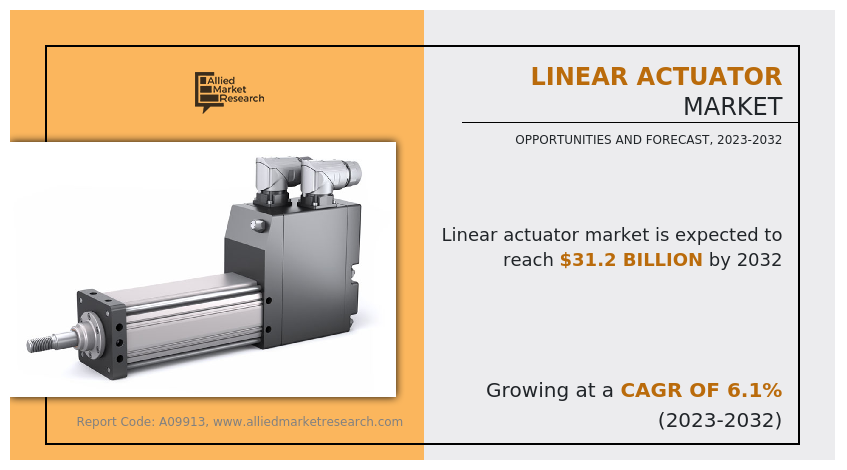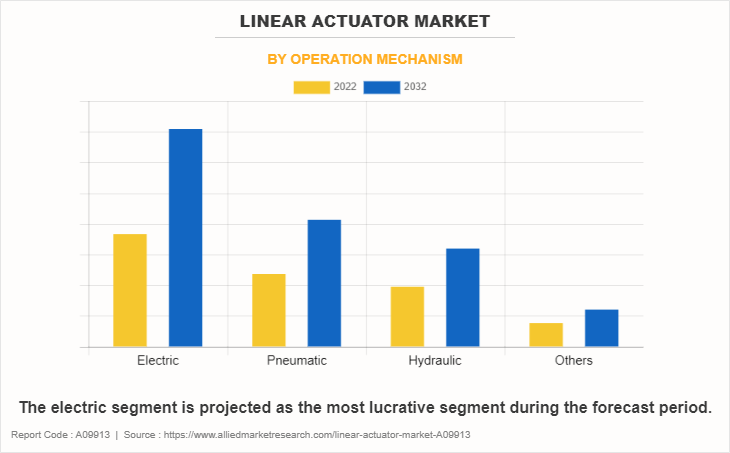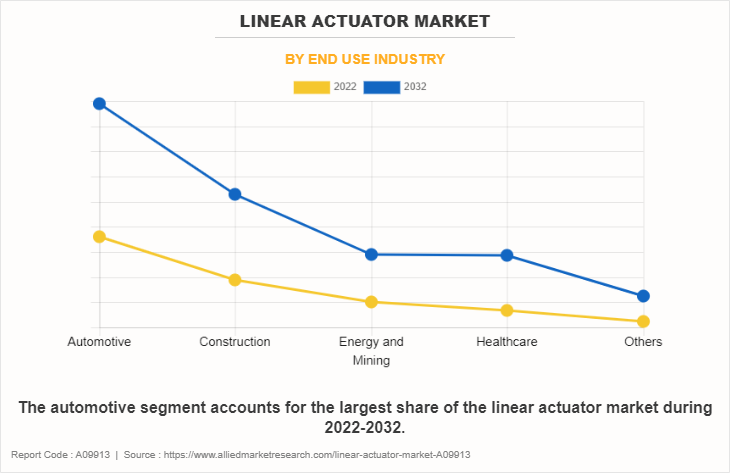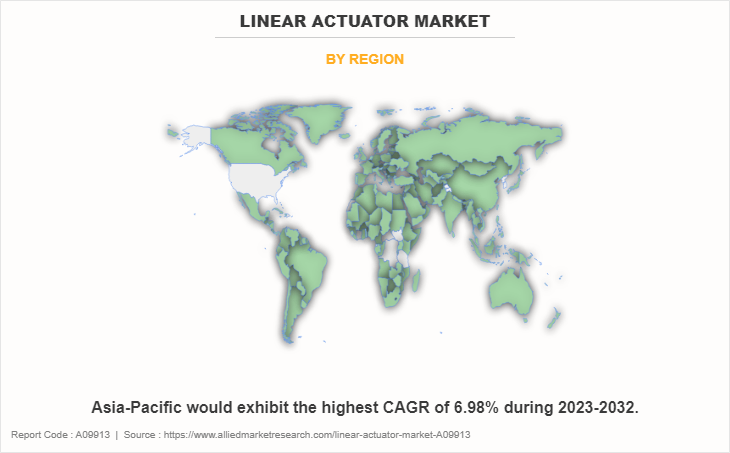Linear Actuator Market Research, 2032
The global linear actuator market was valued at $17.4 billion in 2022 and is projected to reach $31.2 billion by 2032, growing at a CAGR of 6.1% from 2023 to 2032.
A linear actuator is a device designed to create movement in a straight line. It operates by changing electricity, available in forms including electric, hydraulic, or pneumatic, into linear motion. This sort of motion is crucial for some obligations, which encompass pushing, pulling, lifting, and accurately positioning items. Linear actuators are drastically applied across numerous industries including commercial automation, vehicle manufacturing, robotics, and client electronic gadgets, due to their precision in controlling movement and placement. They are crucial in structures in which particular and controlled linear motion is needed.

Linear actuators are extremely adaptable and are used in many modern machinery and systems. Depending on the application, their design might range from basic, small-scale actuators used in electrical gadgets to big, powerful units used in industrial machinery. The energy source used by a linear actuator has a significant impact on its design and use. Electric linear actuators, for example, operated by electric motors, are widely employed in robotics and consumer electronics for accurate motion control. Hydraulic actuators, which work on fluid pressure, are more typically found in heavy-duty machinery due to their capacity to generate significant force and great power efficiency.
Segment Overview
The linear actuator market is segmented based on operation mechanism, end-use industry, and region.
Based on operation mechanism, the market is divided into electric linear actuators, pneumatic linear actuators, hydraulic linear actuators, and others.

In terms of end-use industry, the market is categorized into automotive, construction, energy & mining, health care and others.

Based on region, the market is analyzed across North America (US, Canada, and Mexico), Europe (UK, Germany, France, rest of Europe), Asia Pacific (China, Japan, India, and South Korea, and the rest of Asia Pacific) and LAMEA (Latin America, Middle East, and Africa).

Country-wise, during the projected period of 2023-2032, the U.S. has earned a considerable linear actuator market share in North America. This dominance stems from its excellent technical infrastructure, substantial industrial sectors, and great emphasis on automation and innovation.
In Europe, Germany has solidified its role as a dominant participant in the linear actuator marketplace in phrases of sales percentage in 2022, and this trend is expected to hold all through the forecast length. Germany's dominance in this market may be attributed to its superior production zone, robust emphasis on engineering and technological innovation, and massive funding in automation technology.
China is expected to become an important market for the linear actuator sector in the Asia-Pacific area. This expansion is largely driven by its fast-increasing industrial sector, significant expenditures in automation, and a strong emphasis on manufacturing technical breakthroughs.
Latin America has established itself as the main player in the LAMEA region linear actuator market, gaining the greatest revenue share in 2022. This is due to the country's rising industrialization, increased use of automated technology in industry, and increased investment in infrastructure development.
The rise in demand in the automotive industry significantly drives the linear actuator market, as these industries increasingly rely on precision and efficiency in their production lines. Linear actuators play a crucial role in automotive manufacturing processes, offering the precise control and movement necessary for assembling complex vehicle components. The requirement for high-quality, reliable linear actuators escalates as the automotive industry evolves with more advanced and automated manufacturing techniques. This is not only to enhance production efficiency but also to maintain the stringent standards of precision and quality expected in automotive manufacturing. Consequently, this growth in demand from the automotive sector substantially boosts the market for linear actuators.
However, the complexity involved in the installation and maintenance of linear actuator systems hinders the growth of the linear actuator market. Advanced linear actuators, particularly those integrated into advanced automation or control systems, often require specialized knowledge for proper installation and maintenance. This complexity can pose challenges for users, particularly if they lack the technical expertise or resources to manage these systems effectively. It can lead to increased costs for training or hiring skilled personnel and might also result in longer downtime during maintenance or setup, affecting productivity. Such complexities are expected to hinder potential users, especially in sectors where ease of use and low maintenance are key factors. As a result, the complex nature of installing and maintaining these advanced systems is expected to hinder market growth, as it raises the barriers to entry and ongoing operation for many potential users.
Customization for specific applications represents a significant opportunity in the market despite this restraint, as it allows manufacturers to meet the unique requirements of various industries. For example, in the robotics industry, custom-designed linear actuators can be tailored to offer precise control and compact size, essential for intricate tasks and confined spaces common in robotic applications. This level of customization ensures that actuators not only fit the physical dimensions required by the robots but also deliver the exact performance characteristics needed, such as speed, force, and durability. Such tailored solutions enhance the functionality and efficiency of industrial equipment, demonstrating the value of adapting linear actuators to specific application needs.
The most important role in industrial automation systems is played by the actuator linear technology. These actuator linear devices are known for their precise and controlled linear movements, which make them indispensable in applications such as production equipment or robotics. Unprecedented reliability is offered by the actuator linear systems, which ensure safe and efficient operation in different sectors to further improve productivity.
Top Impacting Factors
The linear actuator marketplace is predicted to witness awesome growth attributable to increased automation in manufacturing, advancements in robotics, and miniaturization of gadgets. Moreover, Internet of Things (IoT) integration is predicted to provide a rewarding possibility for the growth of the marketplace at some point in the forecast length. On the opposite, a high preliminary investment fee limits the linear actuator market growth.
Competitive Analysis
The linear actuator market analysis report highlights the highly competitive nature of the linear actuator market, owing to the strong presence of existing vendors. Vendors with extensive technical and financial resources are expected to gain a competitive advantage over their counterparts by effectively addressing linear actuator market demands. The competitive environment in this market is expected to increase as product launches, expansion, new product development, geographical expansion, and product upgrade/development kind of strategies adopted by key vendors increase. Competitive analysis and profiles of the major linear actuator market players that have been provided in the report include Bosch Rexroth AG, Emerson Electric Co., HepcoMotion Ltd., Kollmorgen Corporation, LINAK, Oriental Motor Co., Ltd., Parker Hannifin Corporation, Rockwell Automation, Thomson Industries, Inc., Tolomatic, Inc.
Key Developments / Strategies
According to the latest linear actuator market overview, Emerson Electric Co., Kollmorgen Corporation, Parker Hannifin Corporation, Rockwell Automation Inc., and Bosch Rexroth AG are the top 5 players in the linear actuator market. Top market players have adopted various strategies, such as product launches, expansion, new product development, geographical expansion, and product upgrade/development to expand their foothold in the linear actuator market.
- December 2022 - Bosch Rexroth has introduced CytroMotion, a new compact self-contained actuator, to its product line. This system solution, designed for linear movements with forces up to 110 kN, enables more efficient and sustainable operations in smaller spaces. CytroMotion, with a power class of up to 6.2 kW, offers micrometer-precise positioning and combines the robustness of hydraulics in an energy-efficient design.
- June 2022 - Emerson has launched the AVENTICS Series SPRA Electric Actuators, supplying 3 screw technology for excessive precision and cargo capability. These flexible actuators, best for numerous industries, are available in 4 sizes with a couple of mounting options and observe ISO-15552 standards.
Key Benefits For Stakeholders
- To provide an accurate view of future investment pockets, this study provides analytical estimates for linear actuator market size along with current trends and estimations.
- In order to be able to achieve a more prominent position, the overall linear actuators market analysis is based on an understanding of prevailing profitability trends.
- The report presents information related to key drivers, restraints, and linear actuator market opportunities with a detailed impact analysis.
- To measure financial competence, linear actuator market forecasts shall be quantitatively analyzed from 2022 until 2032.
- The Porter Five Force analysis shows that buyers and suppliers are more powerful in the linear actuator market.
- Key vendor shares and linear actuator market trends are included in the report.
Linear Actuator Market Report Highlights
| Aspects | Details |
| Market Size By 2032 | USD 31.2 billion |
| Growth Rate | CAGR of 6.1% |
| Forecast period | 2022 - 2032 |
| Report Pages | 258 |
| By Operation Mechanism |
|
| By End Use Industry |
|
| By Region |
|
| Key Market Players | Oriental Motor Co., Ltd., HepcoMotion Ltd., LINAK, Kollmorgen Corporation, Parker Hannifin Corporation, Thomson Industries, Inc., Bosch Rexroth AG, Tolomatic, Inc., Emerson Electric Co., Rockwell Automation Inc. |
Analyst Review
The linear actuator market has experienced rapid expansion. Several important causes have contributed to its expansion. Advances in industrial automation and the automobile sector are two of the key drivers of this expansion. A important cause is the increased usage of linear actuators in automotive applications, where they play a critical role in improving vehicle performance, comfort, and efficiency. Electric actuators, for example, are utilised in vehicle seats to modify lumbar support systems and seat placement angles. Another important trend driving market expansion is the adoption of smart actuators and IoT-enabled systems, which are essential to the advancement of Industry 4.0. These intelligent actuators have sophisticated features such as potentiometers, rotary encoders, network switches, and controllers, resulting in more efficient operation.
Moreover, Asia Pacific is expected to grow at a rapid pace as the market for Linear Actuators. The growth can be attributed to different sectors of the Asia Pacific region, notably in China and India, where automated technologies are on the rise. This growth is driven by the industrial sector, which uses linear drives to drive robots and packaging or material handling in addition to automotive industry. Demand for Linear Actuators is also expected to increase in Asia Pacific, owing to the increasing use of intelligent homes and home appliances.
A highly competitive environment prevails in the worldwide linear actuators market, with top businesses pursuing tactics such as mergers, acquisitions, strategic alliances, and product innovation. Leading companies like as Bosch Rexroth AG, Parker Hannifin Corporation, and Thomson Industries Inc. are at the forefront, aggressively product launches, expansion, new product development, geographical expansion, and product upgrade/development to strengthen their market position. One such example is the collaboration between Parker Hannifin Corporation and lidar sensor expert Ouster to develop sophisticated automation solutions.
The linear actuator market is expected to grow at a CAGR of 6.05% during the period of 2023 to 2032.
The industry size of linear actuators is estimated to be $17,439.2 million in 2022.
Asia-Pacific is the largest regional market for linear actuators.
The leading application of the linear actuator market is in the field of automotive.
The top companies holding significant market share in the superconductors industry include Emerson Electric Co., Kollmorgen Corporation, Parker Hannifin Corporation, Rockwell Automation Inc., and Bosch Rexroth AG.
Loading Table Of Content...
Loading Research Methodology...



